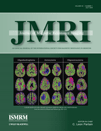Automated assessment of whole-body adipose tissue depots from continuously moving bed MRI: A feasibility study
Abstract
Purpose
To present an automated algorithm for segmentation of visceral, subcutaneous, and total volumes of adipose tissue depots (VAT, SAT, TAT) from whole-body MRI data sets and to investigate the VAT segmentation accuracy and the reproducibility of all depot assessments.
Materials and Methods
Repeated measurements were performed on 24 volunteer subjects using a 1.5 Tesla clinical MRI scanner and a three-dimensional (3D) multi-gradient-echo sequence (resolution: 2.1 × 2.1 × 8 mm3, acquisition time: 5 min 15 s). Fat and water images were reconstructed, and fully automated segmentation was performed. Manual segmentation of the VAT reference was performed by an experienced operator.
Results
Strong correlation (R = 0.999) was found between the automated and manual VAT assessments. The automated results underestimated VAT with 4.7 ± 4.4%. The accuracy was 88 ± 4.5% and 7.6 ± 5.7% for true positive and false positive fractions, respectively. Coefficients of variation from the repeated measurements were: 2.32 % ± 2.61%, 2.25% ± 2.10%, and 1.01% ± 0.74% for VAT, SAT, and TAT, respectively.
Conclusion
Automated and manual VAT results correlated strongly. The assessments of all depots were highly reproducible. The acquisition and postprocessing techniques presented are likely useful in obesity related studies. J. Magn. Reson. Imaging 2009;30:185–193. © 2009 Wiley-Liss, Inc.




